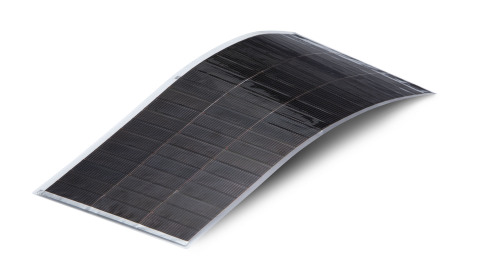CHICAGO — (BUSINESS WIRE) — April 29, 2019 — Alta Devices;
This press release features multimedia. View the full release here: https://www.businesswire.com/news/home/20190429005209/en/

Alta Devices Anylight™ Solar for HALE UAVs (Photo: Business Wire)
| What: |
HALE (High Altitude Long Endurance) UAVs and HAPS (High Altitude Pseudo-Satellites) are massive aircraft, often with wingspans as large as a Boeing 747, that rely on solar power to remain aloft for multiple weeks, or even months, at a time. The stratosphere, at an altitude of 20 kilometers (60,000 feet), poses unique engineering challenges to aircraft due to its harsh conditions. For these innovative aircraft to fly successfully, they require disruptive technologies such as new types of sensors, batteries, materials, software, and wing designs. Until now, solar technology designed specifically to meet the unique needs of these aircraft did not exist. Recently, however, Alta Devices announced its new solar product, Alta Devices Anylight™ Solar for HALE UAVs.
|
||
|
Alta Devices has a history of world-class innovation with its world record-breaking solar technology, designed to power autonomous systems. Its Anylight™ Solar for HALE UAVs technology is high efficiency, lightweight, and flexible. It extends endurance and range by providing more power to batteries, and can also power additional payload. This solar technology can be simply applied to aircraft surfaces. Alta Devices Anylight™ Solar for HALE UAVs is designed specifically to power stratospheric flight. |
|||
| Why: |
HALE UAVs and HAPS are an important new aircraft category and can include airplanes, airships, and/or balloons that are designed to fly at altitudes of 20 kilometers (60,000 feet) for extended periods of time. In addition to being used for a variety of communications (such as cell phone connectivity and others), these aircraft can be used for intelligence, surveillance, and reconnaissance (ISR), search and rescue, border patrol, mapping, and many other applications. Solar power is critical for these aircraft, particularly because the objective is to fly for years without refueling.
|
||
|
Flight at this altitude demands solar technology that is different from the type used in terrestrial installations or space. For example, at 60,000 feet, ultraviolet radiation from the sun is more intense than on the earth’s surface. Unlike in space with zero gravity, the generation of lift is important for stratospheric vehicles. In order to allow the aircraft to carry a useful payload and enough batteries for night flight, the solar technology used must be extremely light-weight. In contrast to both terrestrial and space applications, at 60,000 feet, mechanical stresses during flight can be very tough on the aircraft surface and solar panels, so the solar material must be flexible and durable. |
|||
| Where and When: |
XPONENTIAL
2019
|
||
|
Exhibition and discussion of solar technology for unmanned systems. Alta Devices will discuss why breakthrough solar solutions for stratospheric UAVs are not the same as terrestrial or space solar. This will include details about its latest product, Alta Devices Anylight™ Solar for HALE UAVs, the first solar technology designed for stratospheric flight. Also on display, will be UAV solar wing segments, solar modules, and information on Alta Devices technology. |
|||
|
Case Study: How the NRL Flew the Hybrid Tiger Using Alta's Solar Power |
|||
| Monday April 29, 4:00pm – 4:30pm| Room S404a | |||
| Ian Murray- Engineer, Alta Devices | |||
|
The main limitation currently facing the UAV market is the short flight time of these aircraft. Alta solar cells offer a way to capture energy while flying without compromising the weight, size, or maneuverability of an aircraft. Researchers at the U.S. Naval Research Laboratory (NRL) chose Alta Devices thin, flexible, GaAs technology to integrate into the surface of a UAV wing to achieve extended flight time. This discussion will cover the integration process and the test flight results. |
|||
|
Panel Discussion: Flying High: The Latest Developments in High Altitude UAS |
|||
| Wednesday May 1, 3:00pm – 4:00pm| Room S402a | |||
| Rich Kapusta- CMO and Head of Sales, Alta Devices | |||
|
Significant developments are being made in the HALE UAV and HAPS field as these systems prove their worth delivering persistent coverage for telecommunications, public safety missions, and internet connectivity. Hear from companies leading in the development of these platforms and the enabling technologies that support them. |
|||
|
Panelists include: Rich Kapusta - Alta Devices (Moderator), Nigel Chandler – AIRBUS Defence and Space, Martin Topping – BAE Systems, Matt Ciuca - Aurora Flight Sciences Corporation. |
|||
About Alta Devices: Alta Devices is empowering autonomy by delivering the world’s most efficient, thin and flexible mobile power technology. By converting light of any kind into electricity, Alta Devices AnyLight™ power technology extends the energy source of a system, and in many cases, completely cuts the traditional power cord. The solution can be completely integrated into the final system, and is ideal for use in automotive, unmanned systems, satellites, consumer electronics, sensors or anywhere size, weight, and mobility matter. Alta Devices holds world records for energy conversion efficiency and is headquartered in Sunnyvale, CA. For more information, visit http://www.altadevices.com. Alta Devices is a Hanergy company.
All trademarks and registered trademarks are those of their respective companies.
View source version on businesswire.com: https://www.businesswire.com/news/home/20190429005209/en/
Contact:
For press information contact:
Abigail Johnson
Roeder-Johnson
Corporation
(650) 395-7078
http://email.roeder-johnson.com
For customer information contact:
Rich Kapusta, Chief
Marketing Officer
Alta Devices
(408) 585-2050
Email Contact